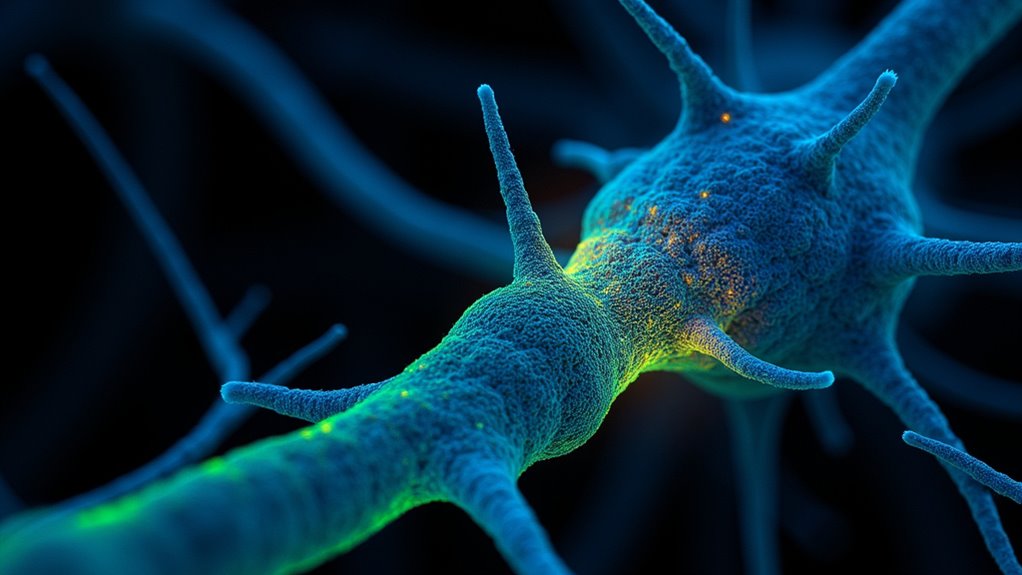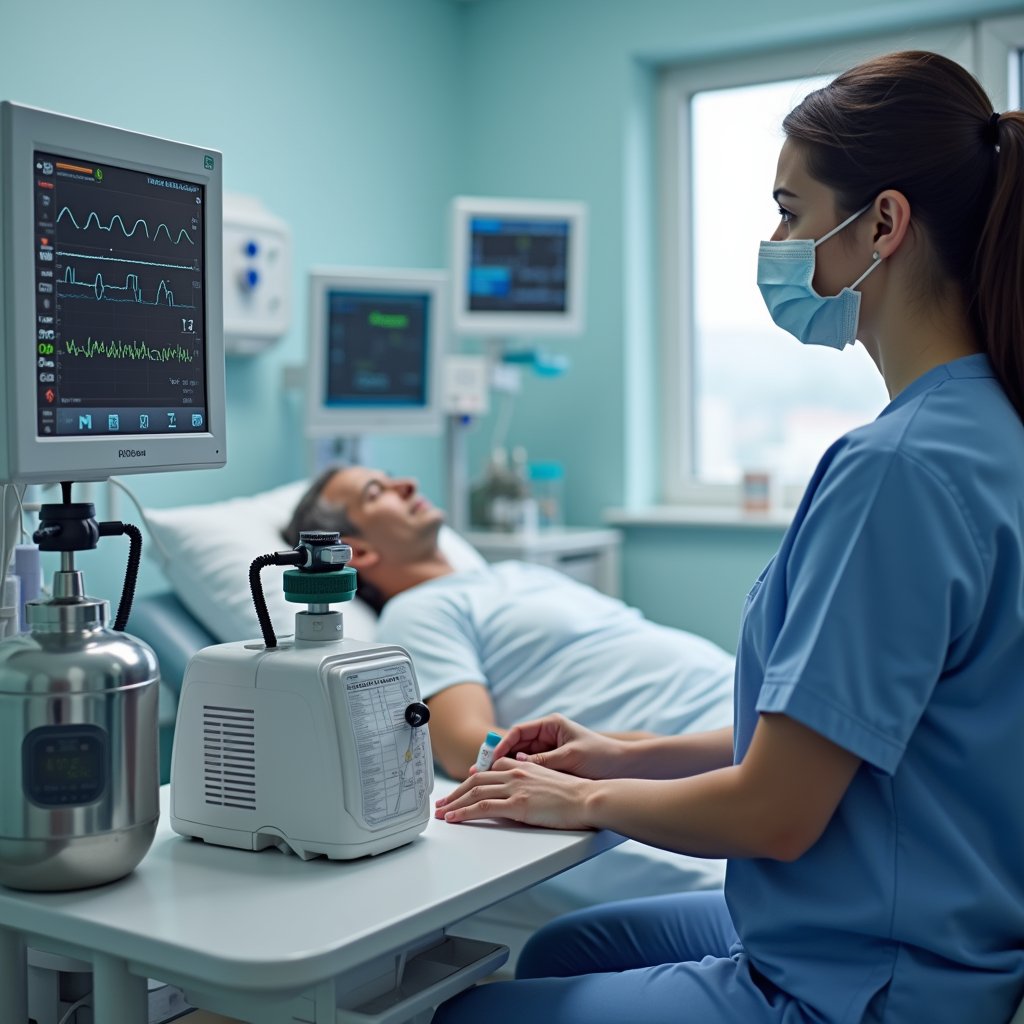Recent studies show nitrous oxide’s remarkable 91.7% antidepressant efficacy and 75% remission rates through its SK2 channel inhibition mechanism. You’ll find it produces positive effects lasting up to two weeks from a single session, while activating critical neural circuits in the prefrontal cortex and VTA-NAc pathways. Medical professionals must monitor B12 levels and maintain strict safety protocols during administration. These breakthrough findings open new horizons for treating depression-resistant patients.
Clinical Research Discoveries and Outcomes

Three major clinical research breakthroughs have emerged from recent nitrous oxide studies. Uncovered, trials have demonstrated remarkable antidepressant efficacy, with 91.7% of patients showing significant symptom reduction and 75% achieving remission when used as adjunct therapy. This has led to new prescriptive therapy guidelines for treatment-resistant cases. A single session can produce positive effects lasting up to two weeks duration in some patients.
Recent studies reveal nitrous oxide’s powerful antidepressant potential, with over 90% of patients showing major improvements in treatment-resistant depression.
Second, researchers have identified nitrous oxide’s unique SK2 channel inhibition mechanism, which bypasses traditional NMDA pathways. This finding’s prompting development of oral medications that could revolutionize depression treatment. Recent Michigan data shows 144 poison center cases highlighting the risks of non-medical use.
Third, pediatric dental applications continue showing exceptional safety profiles under strict ethical oversight obligations, with minimal adverse events reported in controlled settings. The FDA recently warned that any recreational misuse outside of medical supervision can lead to severe health complications.
These findings are reshaping clinical protocols while highlighting the critical distinction between medical applications and concerning recreational use trends.
Treatment Mechanisms in Brain Chemistry

N2O’s activation of SK2 potassium channels triggers neural circuit adaptations through membrane hyperpolarization and altered ion flux patterns.
You’ll observe that these SK2-mediated effects interface with the drug’s NMDA receptor antagonism, creating synchronized changes in neural firing rates and synaptic strength.
The resulting modulation of brain circuit activity produces both therapeutic outcomes and potential risks, particularly in regions governing consciousness and pain processing.
The activation of opioid peptide release in the brainstem contributes to its pain-relieving properties through descending noradrenergic pathways.
The selective targeting of GABA receptors creates an anxiolytic response that enhances patient comfort during dental procedures.
At elevated temperatures, the gas exhibits enhanced reactivity, significantly altering its pharmacological interactions with neural substrates.
SK2 Channel Pathway Effects
Recent molecular studies reveal that nitrous oxide’s antidepressant effects stem primarily from its unique interaction with SK2 channels in the brain’s layer 5 neurons. Through direct pore blockade, N₂O disrupts normal channel kinetics by becoming trapped in the selectivity filter, with molecular dynamics showing escape barriers exceeding 8 kcal/mol.
When N₂O blocks these channels, it reduces calcium-sensitive potassium outflow and decreases medium afterhyperpolarization in L5 neurons. This action persists even after gas discontinuation, shifting neural circuits from a hypoactive to hyperexcitable state. Unlike ketamine’s NMDA-dependent effects, N₂O’s SK2 pathway represents a novel therapeutic target that doesn’t require NMDA receptor involvement for its antidepressant properties. This mechanism offers hope for the approximately one-third of patients who don’t respond to traditional antidepressant treatments.
Neural Circuit Activity Changes
Beyond SK2 channel blockade, nitrous oxide triggers complex neural circuit modifications across multiple brain regions. You’ll find that neurotransmitter modulation occurs through activity-dependent plasticity mechanisms, leading to persistent therapeutic effects even after the gas leaves your system.
- nNOS activation in your medial prefrontal cortex initiates antidepressant effects, requiring repeated exposure for sustained benefits
- Your VTA-NAc dopamine circuit experiences augmented D1 receptor function and BDNF signaling, improving mood regulation
- Layer 5 pyramidal neurons in your cingulate cortex show reduced inhibition, reactivating stress-suppressed emotional circuits
- Primary motor cortex demonstrates increased firing rates from 8.1 to 10.6 Hz, with heightened beta/gamma spectral power
These circuit-specific changes reveal distinct regional responses, with emotional centers showing therapeutic activation while motor networks undergo processing alterations. Advanced calcium imaging technology revealed these detailed neural activity patterns in stressed mice, providing unprecedented insight into the mechanism of action. The study found that NMDA receptor antagonism was the primary mechanism of action, rather than effects on GABAergic transmission.
Safety Concerns and Risk Management

Medical professionals must monitor essential signs, oxygen saturation, and B12 levels when administering nitrous oxide to prevent adverse events and identify early warning signs of toxicity.
You’ll need continuous pulse oximetry and blood pressure tracking during administration, with emergency protocols in place to address potential complications including respiratory depression and cardiovascular instability. Converting delivery methods to portable supply systems can significantly enhance organizational safety and monitoring capabilities.
Recent data shows emergency visits have increased by 32% as more people misuse this substance. Your healthcare provider should implement a B12 supplementation protocol if you’re receiving repeated nitrous oxide exposure, as chronic use can rapidly deplete B12 stores and lead to serious neurological complications. Proper medical supervision is critical since repeated inhalation of nitrous oxide without monitoring can have potentially deadly long-term effects on the body.
Clinical Monitoring Requirements
Clinical monitoring of nitrous oxide administration demands rigorous safety protocols and thorough risk management strategies to guarantee both patient and staff well-being. Multiple studies, including research by Babl et al. examining adverse events, demonstrate the importance of comprehensive safety monitoring in pediatric sedation. NIOSH research indicates that proper scavenging systems can decrease N2O concentrations by over 70% in clinical settings. You’ll need to implement complete monitoring systems that align with NIOSH standards while maintaining strict equipment maintenance schedules and ergonomic considerations for ideal safety.
- You must facilitate continuous monitoring using infrared gas analyzers, maintaining the recommended 25 ppm TWA exposure limit during procedures
- Your staff requires basic life support certification and specialized 6-hour training covering sedation protocols and management strategies
- You’ll need to maintain proper ventilation systems with time-integrated sampling using impervious bags and battery-powered pumps
- Your facility must implement regular equipment maintenance checks, including ergonomic positioning of monitoring devices and proper calibration of all measurement instruments
Overdose Prevention Strategies
Implementing extensive overdose prevention strategies requires a multi-faceted approach that integrates environmental safety protocols, substance access controls, and evidence-based harm reduction techniques.
You’ll need to prioritize proper ventilation, avoid isolated locations, and maintain safe distances from flammable materials. Community outreach programs emphasize the importance of using intact dispensers, taking oxygen recovery breaks, and never inhaling directly from canisters to prevent frostbite injuries. Users may experience potentially dangerous effects like blurred vision and dizziness. Regulatory enforcement strategies focus on restricting sales to approved vendors and implementing maturity verification systems.
Key prevention measures include monitoring poison center data, enforcing purchase limits, and establishing standardized retailer guidelines. You should understand that combining nitrous oxide with alcohol or other substances drastically increases risks of respiratory depression and accidents. Regular B12 monitoring is essential for detecting early signs of neurotoxicity.
B12 Deficiency Management
A thorough B12 deficiency management strategy requires vigilant monitoring of serum levels and early intervention protocols, particularly for individuals exposed to nitrous oxide. Early symptom recognition and proactive dietary supplementation are essential elements in preventing severe neurological complications.
- Monitor methylmalonic acid (MMA) levels, as they’re more sensitive indicators than serum B12 measurements alone, enabling earlier detection of deficiency.
- Implement high-dose oral supplementation (1-2mg daily) immediately following nitrous oxide exposure, with potential intramuscular injections for severe cases.
- Conduct regular neurological assessments, including Romberg tests and nerve conduction studies, to track potential deterioration.
- Establish comprehensive dietary plans focusing on B12-rich foods while considering patient-specific factors such as age-related absorption issues or vegetarian dietary restrictions.
Public Health Impact and Prevention Strategies
Recent epidemiological data reveals three alarming trends in nitrous oxide misuse across developed nations. Primarily, poison center calls increased from 10 to 48 cases between 2019-2023, while emergency department visits jumped from 7 to 60.
Second, young adults aged 20-39 in metropolitan areas represent the highest risk group, with nitrous oxide ranking as the second most common recreational drug among UK youth aged 16-24.
Lastly, 7.3% of EMS responses involved fatalities, including three suspected suicides.
You’ll find these trends have prompted urgent regulatory policy changes and public awareness campaigns. Key prevention strategies now target polysubstance use, as many cases involve concurrent use of benzodiazepines, cannabis, and alcohol. Early intervention programs specifically focus on metropolitan areas where misuse rates continue to climb substantially.
Future Drug Development Pathways
While public health measures address immediate nitrous oxide misuse concerns, significant pharmaceutical development efforts have emerged across multiple therapeutic pathways. Clinical trials spanning 2020-2022 demonstrate active advancement in dose optimization strategies and pipeline expansion challenges across diverse therapeutic areas.
Inhaled nitric oxide is progressing through Phase 1 trials for neoplasms, with researchers focusing on safety thresholds and direct tumor targeting. nNOS inhibitors are showing promise in preclinical development for autism spectrum disorder, expanding beyond conventional applications. STAT3 inhibitors are revolutionizing drug delivery techniques, with potential applications spanning multiple therapeutic domains. Portable delivery systems are replacing centralized infrastructure, enabling broader clinical adoption while reducing environmental impact.
These developments reflect a shift in the direction of targeted therapies and cutting-edge administration methods, setting the stage for next-generation treatments.
Therapeutic Applications and Benefits
Substantial clinical evidence demonstrates nitrous oxide’s versatile therapeutic applications across multiple medical domains. You’ll find its most prominent benefits in obstetric labor support, where it provides effective analgesia without compromising maternal or fetal safety. Clinical data shows it can reduce labor duration while allowing mothers to maintain control through self-administration systems.
In dental settings, the agent excels at providing procedural anxiolysis, particularly beneficial for both adult and youthful patients undergoing invasive procedures. You’ll notice its rapid onset and short length make it ideal for single-chairside administration.
The drug’s effectiveness extends to mental health applications, where research indicates promise in treating resistant depression at 25% concentrations. When administered as a 20%-70% mixture with oxygen, it maintains a sturdy safety profile while delivering consistent therapeutic outcomes.
Frequently Asked Questions
How Does Altitude Affect Nitrous Oxide Treatment Efficacy in Clinical Settings?
As you administer nitrous oxide at higher altitudes, you’ll notice decreased analgesic efficacy due to reduced partial pressures.
At 3,300m, you’ll experience a 71.5% reduction in pain threshold effects compared to sea level, driven by pharmacokinetic fluctuations. You must carefully monitor for hypoxic conditions, as oxygen requirements increase considerably with elevation.
To maintain effectiveness, you’ll need to adjust N2O concentrations to compensate for altitude-induced pressure changes.
Can Patients Develop Tolerance to Nitrous Oxide’s Antidepressant Effects Over Time?
Current evidence doesn’t conclusively show rapid tolerance development with nitrous oxide’s antidepressant effects. You’ll find that clinical data suggests a 50% response rate with sustained benefits lasting up to a week post-treatment.
While there’s limited research on prolonged treatment durations, you won’t typically see the same tolerance patterns observed with recreational use. The presence of depression may actually serve as a protective factor against tolerance formation.
What Dietary Restrictions Should Patients Follow Before Nitrous Oxide Therapy?
Before receiving nitrous oxide therapy, you should follow moderate dietary restrictions. You can have clear liquids up to 2 hours before treatment and light meals 4-6 hours prior. It’s best to maintain normal dietary fiber intake but avoid heavy or fatty foods. You don’t need special nutritional supplementation requirements, but you should avoid solid dairy products.
If you’re combining nitrous oxide with oral sedation, you’ll need to follow stricter fasting guidelines.
Are There Genetic Factors That Predict Better Response to Nitrous Oxide Treatment?
While genetic factors can influence your response to nitrous oxide, research on specific genetic markers is still emerging. Your individual metabolism, particularly variations in NOS genes (NOS1, NOS2, and NOS3), may affect how you process the gas. These genetic differences can impact nitric oxide signaling pathways and potentially influence treatment outcomes.
However, there’s not yet enough evidence to use genetic testing to predict nitrous oxide effectiveness in clinical settings.
How Do Different Storage Conditions Affect Nitrous Oxide’s Therapeutic Properties?
You’ll find that storage conditions vastly impact nitrous oxide’s therapeutic effectiveness. High humidity levels can introduce moisture contamination, reducing the gas’s purity and medicinal properties.
Storage temperatures must stay between -13°F and 0°F for refrigerated liquid storage to maintain potency. You should also maintain proper pressure (260-315 psi) and guarantee dry, well-ventilated storage areas to preserve the gas’s therapeutic qualities and prevent degradation that could compromise patient safety.

